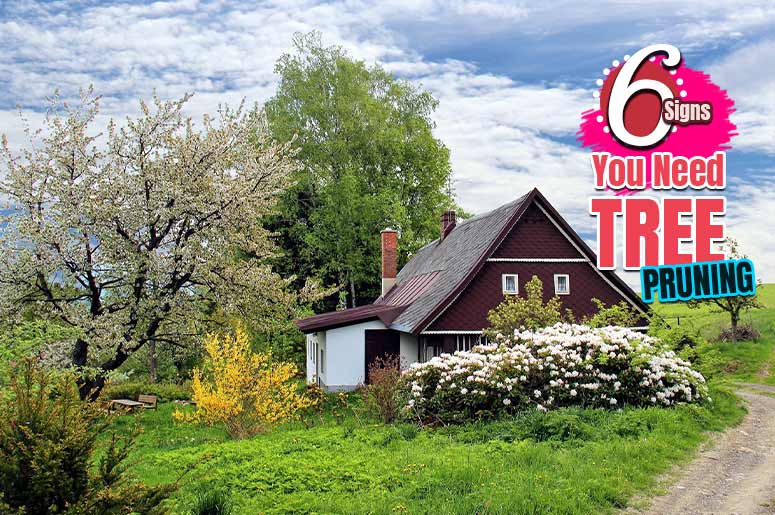Maintaining your trees is essential for promoting healthy growth, ensuring safety, and enhancing the visual appeal of your property. One crucial aspect of tree care is pruning – a process that involves the removal of branches or parts of the tree. Pruning can prevent diseases, mitigate hazards, and improve the overall structure of trees.
Unpruned trees pose significant risks to people and property. For example, weak branches can break and fall, causing injury or damage to surrounding structures. Additionally, branches that touch power lines or grow too close to buildings can be hazardous.
To minimise risk and prevent these hazards, it is important to inspect your trees regularly and look for signs indicating when pruning is necessary. Here are six common signs that your tree needs pruning:


1. Deadwood
Noticing deadwood on your tree or its branches could possibly mean that the tree is dying. Deadwood is more susceptible to disease and can be hazardous, potentially causing harm to your tree’s overall structure and surroundings. These signs of decay should prompt you to remove dead parts of your tree, regardless of the season. When deadwood is removed at the right time, you can prevent its dangers and save the entire tree.
2. Broken Branches
After a heavy storm sweeps through your property, checking your trees thoroughly is important. Upon checking, it is not uncommon for you to see multiple broken limbs and branches hanging from a tree. These branches must be removed immediately as they are loosely connected and could easily fall at any time. Cutting these broken tree parts in such situations is best left to professionals. Never risk your own safety, especially when dealing with broken branches of large trees. Saving some coin is just not worth the risk it brings.
3. Branch Density
Trees that grow too thick prevent adequate light and airflow from reaching the centre of the tree, weakening it and making it more vulnerable to damage. Additionally, they often develop crossing branches that rub against each other, leading to decay. To ensure that your tree’s branches and other parts remain strong and healthy, it is essential to reduce its branch density. Spring is the best time for pruning in this situation, as you can clearly see through your tree and its branches.
4. Mis-Shaped Trees
When regular pruning is neglected, trees can develop an unbalanced and unappealing shape. Apart from the aesthetic, misshaped trees can’t distribute their weight proportionately, which can damage the tree or surrounding property. It’s best to prune your trees regularly as they grow. However, it’s never too late to start trimming to make sure they won’t cause any trouble.
5. Wild Branches
Wild or uncontrolled tree branches that have grown into structures, utility lines, road signs, or your neighbour’s property can pose serious hazards and liabilities. Such branches can cause power outages, accidents, and property damage. When you notice branches growing uncontrollably and coming into contact with sensitive areas and properties, it is crucial to call an experienced tree care professional who can safely remove these dangerous limbs. In some cases, they may even suggest removing the entire tree to prevent similar dangers from arising.
6. Cracks
If you notice cracks in your tree, it may indicate it is under stress – due to disease or the beginning of rot. Regardless of the case, this will weaken your tree and cause it to become hazardous. In such cases, you should call an experienced arborist to get a professional diagnosis of what’s happening. They can also better prune your tree to ensure only the dangerous parts are removed. In addition, tree care professionals can provide advice on restoring your tree’s health and suggest ways to improve its overall care.
Benefits of Tree Pruning
Pruning does not only mean improving the appearance of the trees. Instead, it involves enhancing the tree’s health, safety and longevity. To know its benefits in greater detail, take a look at the below-given points:


Improves overall tree health:
The overall health and vitality of the tree can be improved by removing the dead and diseased branches. By removing these branches, the tree can focus its resources on healthy growth, promoting optimum health and longevity. Taking care of the health of your trees will also help you to increase their lifespan.
Improves safety:
With the help of tree pruning, you can get rid of the branches that may be at risk of falling and causing damage. This is extremely important in areas with buildings or high-traffic areas.
Manages the size of the trees:
Effectively pruning the trees can prevent them from growing too large and affect the other plants and trees beside them. This is particularly important in urban or suburban areas where the space is limited.
Improves light penetration:
By removing excess and crowded branches, the light can penetrate and reach the trees’ interiors. This can improve the health of the trees and also promote photosynthesis.
If you have seen any of these issues on the trees on your property, it is time to start pruning. Better cut all the problematic branches before they become a headache. Make a habit of checking these six signs your tree needs pruning. And if you need a professional opinion, talk to our tree care specialists at Tall Timbers Tree Services. We’d be happy to inspect the condition of your trees and assist you with your tree pruning needs to keep your family, home, and surroundings safe. We’ll handle all the necessary tree work while you enjoy the benefits of healthy and beautiful trees.

